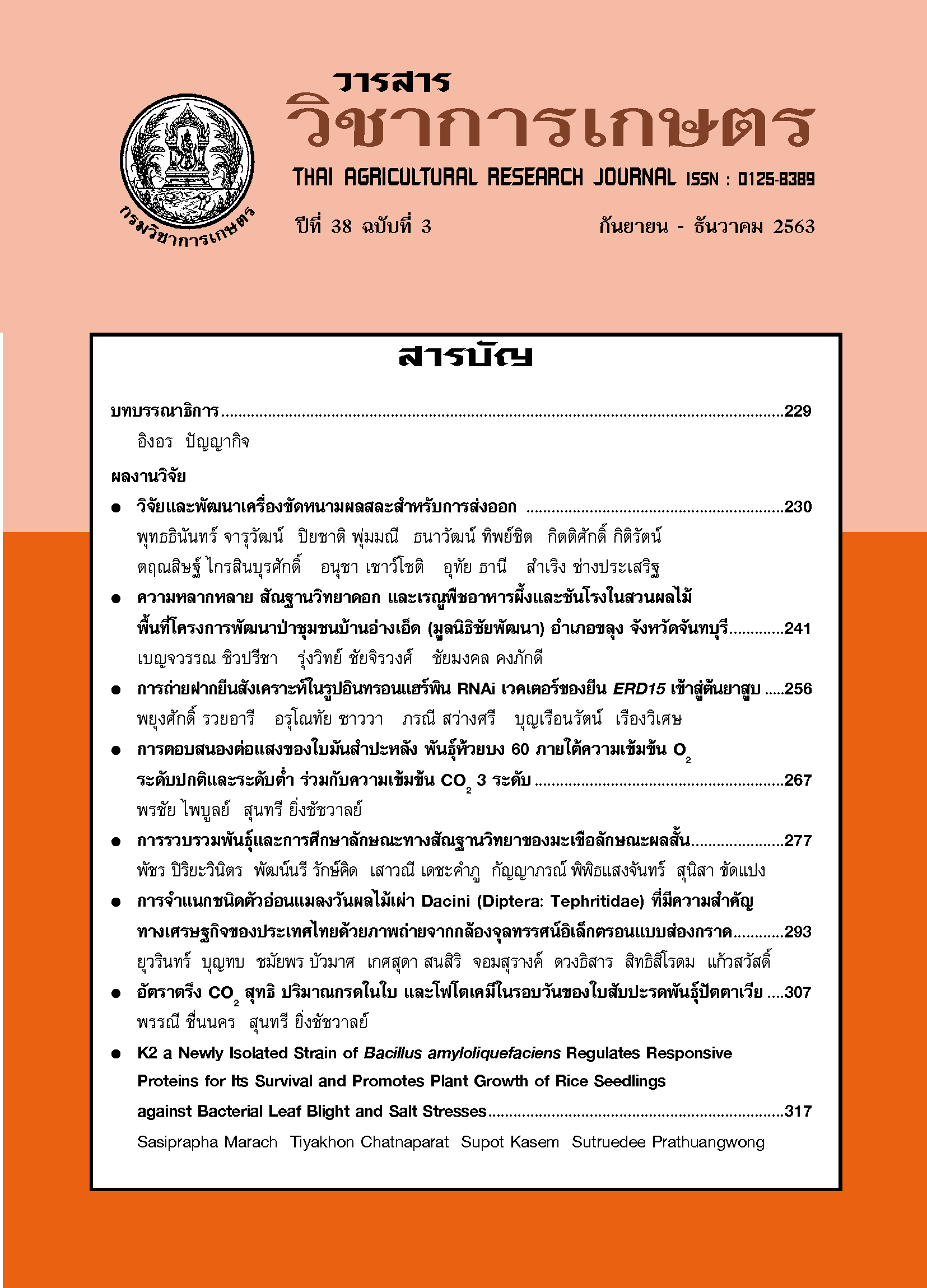วิจัยและพัฒนาเครื่องขัดหนามผลสละสำหรับการส่งออก
DOI:
https://doi.org/10.14456/thaidoa-agres.2020.17คำสำคัญ:
สละ, เครื่องขัดหนาม, ส่งออกบทคัดย่อ
งานวิจัยนี้มีวัตถุประสงค์เพื่อพัฒนาเครื่องขัดหนามผลสละสำหรับการผลิตสละไร้หนาม เพื่อการส่งออก เครื่องขัดหนามผลสละมีขนาด 1.6 x 2 x 0.6 ม. (กว้างxยาวxสูง) ประกอบด้วยชุดโครงเครื่องทำจากเหล็ก ชุดตะแกรงโยกขัดหนาม ผลสละทำจากตะแกรงมุ้งลวด ชุดแปรงขัดประกอบ ด้วยแปรงขัด 2 แปรง ทำจากไนล่อน โดยชุดตะแกรงโยกและชุดแปรงขัดใช้ต้นกำลังมอเตอร์ไฟฟ้าร่วมกัน ขนาด 1 แรงม้า 220 โวลต์ชุดยกตะแกรงโยก ใช้ต้นกำลังมอเตอร์ไฟฟ้า ขนาด 0.5 แรงม้า 220 โวลต์การทำงานของส่วนประกอบเครื่องต้นแบบ ทั้งหมดถูกควบคุมการทำงานเป็นขั้นตอนแบบอัตโนมัติ โดยการเขียนโปรแกรมลงในอุปกรณ์ Programmable Logic Controller (PLC) ซึ่งติดตั้งอยู่ในตู้ควบคุมการทำงานของเครื่อง เครื่องขัดหนามผลสละมีความสามารถในการทำงาน 900 กก./ชม. ใช้กำลังไฟฟ้ารวม 1.47 กิโลวัตต์ สภาวะในการทำงานที่เหมาะสม คือ ความเร็วรอบตะแกรงโยก 110 รอบ/นาทีมุมเอียง 14 องศา สามารถขัดหนามผลสละได้หมด และผลสละสามารถเก็บรักษาได้เกิน 3 วัน ที่อุณหภูมิแวดล้อมปกติโดยไม่เกิดความช้ำและไม่แตกต่างจากการใช้วิธีการเดิม คือ การขัดหนามผลสละด้วยแรงงานคน ซึ่งมีความสามารถในการทำงาน 5 กก./ชม./คน ผลการวิเคราะห์ด้าน เศรษฐศาสตร์วิศวกรรมจากการลงทุนใช้เครื่องต้นแบบในการขัดหนามผลสละ พบว่า มีต้นทุนค่าใช้จ่ายเพียง 82.92 บาท/กก. ในขณะที่การใช้แรงงาน มีต้นทุนค่าใช้จ่ายที่สูงกว่าคือ 90.61 บาท/กก. เมื่อทำการขัดหนามผลสละในปริมาณเท่ากัน
เอกสารอ้างอิง
กรมส่งเสริมการเกษตร. 2560. สละ. แหล่งข้อมูล
http://www.agriinfo.doae.go.th/year60/plant/rortor/fruit2/zalacca.pdf. (สืบค้นเมื่อ 5
กันยายน 2561)
สำนักงานมาตรฐานสินค้าเกษตรและอาหารแห่งชาติ. 2556. มาตรฐานสินค้าเกษตร สละ มกษ. 22-2556.
แหล่งข้อมูล https://www.acfs.go.th/standard/download/SALACCA.pdf. (สืบค้นเมื่อ 23
ตุลาคม 2561)
วิทยาลัยเทคนิคปัตตานี. 2554. เครื่องขจัดหนามสละ. สิ่งประดิษฐ์ของคนรุ่นใหม่ระดับชาติและการแข่งขันหุ่นยนต์ยุวชนอาชีวศึกษา
สำนักงานคณะกรรมการอาชีวศึกษา.แหล่งข้อมูล: URL http://www.youtube.com/watch?v=WZ1PCrdkzGI. สืบค้นเมื่อ: 17 มีนาคม 2557.
ศูนย์นวัตกรรมเทคโนโลยีหลังการเก็บเกี่ยว.2562.ฐานข้อมูลงานวิจัยหมวดหมู่ไม้ผล. แหล่งข้อมูล:http://www.phtnet.org/research/view-abstract.asp?research_id=ah107. สืบค้นเมื่อ: 2 ตุลาคม 2562
วารสารวิชาการเกษตร ปีที่ 38 ฉบับที่ 3 กันยายน - ธันวาคม 2563
เสกสรร สีหวงษ์. 2548. การออกแบบและทดสอบเครื่องทำความสะอาดผลสละ.วิทยานิพนธ์ปริญญา วิทยาศาสตรมหา
บัณฑิต (เทคโนโลยีหลังการเก็บเกี่ยว)มหาวิทยาลัยเกษตรศาสตร์. 92 หน้า.
สำนักข่าวนิวส์พลัส.2563. เครื่องกำจัดหนามสละ ลุยสร้างตลาดส่งออกพร้อมหนุนอุตสาหกรรมแปรรูป. แหล่งข้อมูล: http://
stock.newsplus.co.th/185012. สืบค้นเมื่อ: 18 สิงหาคม 2563.
ดาวน์โหลด
เผยแพร่แล้ว
รูปแบบการอ้างอิง
ฉบับ
ประเภทบทความ
สัญญาอนุญาต
วารสารวิชาการเกษตร



